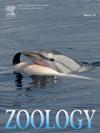Abdominal sensing of substrate vibrations in insects
IF 1.6
3区 生物学
Q2 ZOOLOGY
引用次数: 0
Abstract
Mechanosensation is a universal sensory modality and respective receptors in insects are located in all body parts. For perception of substrate vibrations, highly specialized sensory organs have evolved. In insects, the legs contain specialized vibration sensors, but insects also touch the substrate with other body parts, like their abdomen. Here, we used extracellular recordings from abdominal nerves to test for vibrational sensitivity in two evolutionarily distant insect species. Vibrational stimuli of defined frequencies (30 Hz – 10 kHz) and accelerations (0.01 – 10 m/s2) were applied to the caudal region of the abdomen while recording from nerves associated with mechanosensitive chordotonal organs. In the grasshopper Schistocerca gregaria (Forsskal), abdominal nerves are almost as sensitive to substrate vibrations as the leg nerves. In the cicada Okanagana rimosa (Say), the sensitivity of abdominal sense organs is even higher than that of the leg associated sense organs. In both species, their abdominal tympanate ears are also sensitive to substrate vibrations. The results show that chordotonal organs in the abdomen can significantly contribute to vibration perception in insects.
昆虫腹部对基底振动的感应
机械感觉是一种普遍的感觉方式,昆虫的感受器分布在身体的各个部位。对于基底振动的感知,高度专门化的感觉器官已经进化。昆虫的腿上有专门的振动传感器,但昆虫也会用身体的其他部位(比如腹部)接触基板。在这里,我们使用来自腹部神经的细胞外记录来测试两种进化上遥远的昆虫物种的振动敏感性。定义频率(30 Hz - 10 kHz)和加速度(0.01 - 10 m/s2)的振动刺激应用于腹部尾侧区域,同时记录与机械敏感脊索器官相关的神经。在蚱蜢Schistocerca gregaria (Forsskal)中,腹部神经对基底振动几乎和腿部神经一样敏感。在知了Okanagana rimosa (Say)中,腹部感觉器官的敏感性甚至高于腿部相关感觉器官。在这两个物种中,它们的腹部鼓室状耳朵也对基底振动敏感。结果表明,昆虫腹部的弦纹器官对振动感知有重要作用。
本文章由计算机程序翻译,如有差异,请以英文原文为准。
求助全文
约1分钟内获得全文
求助全文
来源期刊

Zoology
生物-动物学
CiteScore
3.90
自引率
0.00%
发文量
37
审稿时长
70 days
期刊介绍:
Zoology is a journal devoted to experimental and comparative animal science. It presents a common forum for all scientists who take an explicitly organism oriented and integrative approach to the study of animal form, function, development and evolution.
The journal invites papers that take a comparative or experimental approach to behavior and neurobiology, functional morphology, evolution and development, ecological physiology, and cell biology. Due to the increasing realization that animals exist only within a partnership with symbionts, Zoology encourages submissions of papers focused on the analysis of holobionts or metaorganisms as associations of the macroscopic host in synergistic interdependence with numerous microbial and eukaryotic species.
The editors and the editorial board are committed to presenting science at its best. The editorial team is regularly adjusting editorial practice to the ever changing field of animal biology.
 求助内容:
求助内容: 应助结果提醒方式:
应助结果提醒方式:


